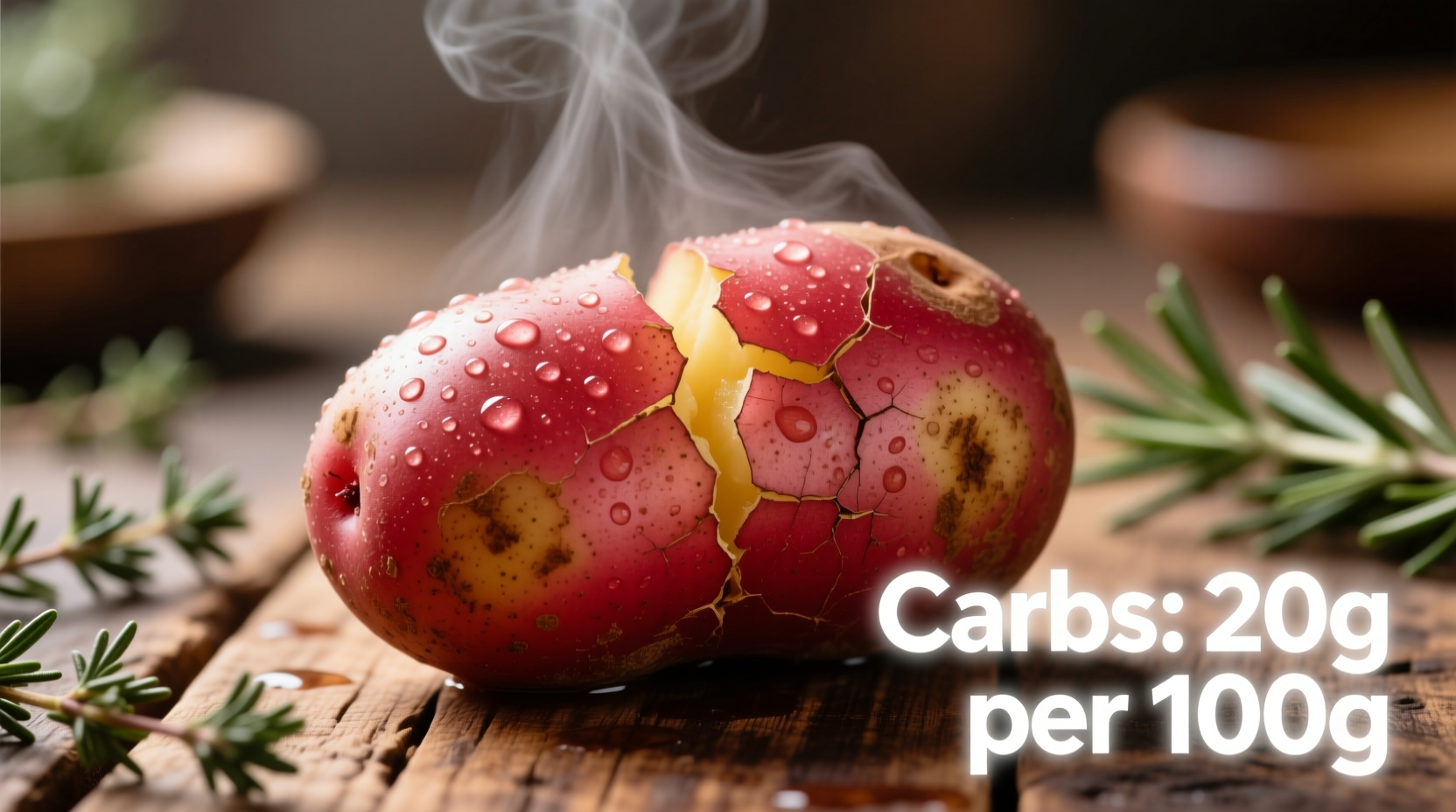Understanding the precise carbohydrate composition of red potatoes helps you make informed dietary choices. Whether you're managing blood sugar, following a specific eating plan, or simply curious about nutrition, knowing exactly what's in your food matters. Let's explore the science-backed facts about red potato carbs and how they fit into various eating patterns.
Red Potato Carb Breakdown: What the Numbers Mean
When evaluating the carbohydrate content of red potatoes, it's essential to look beyond just the total count. The quality and type of carbohydrates significantly impact how your body processes them. According to the USDA's FoodData Central database, here's the detailed nutritional profile for 100 grams of raw red potato:
| Nutrient | Amount per 100g | % Daily Value* |
|---|---|---|
| Total Carbohydrates | 17.49g | 6% |
| Dietary Fiber | 2.2g | 8% |
| Sugars | 0.78g | — |
| Starch | 14.5g | — |
*Based on a 2,000 calorie diet. Source: USDA FoodData Central
This composition reveals why red potatoes shouldn't be categorized simply as "high-carb" foods. The significant fiber content (nearly 13% of the total carbohydrates) slows digestion and prevents rapid blood sugar spikes. The majority of carbohydrates come from complex starches that provide sustained energy release rather than quick sugar rushes.
How Red Potatoes Compare to Other Varieties
Not all potatoes are nutritionally identical. The carbohydrate profile varies between varieties, affecting how they impact your diet. Here's how red potatoes stack up against common alternatives:
| Potato Type | Total Carbs (per 100g) | Fiber (per 100g) | Glycemic Index |
|---|---|---|---|
| Red Potato | 17.5g | 2.2g | 78-85 |
| Russet Potato | 18.8g | 2.1g | 85-110 |
| Sweet Potato | 20.1g | 3.0g | 44-94 |
| White Potato | 17.0g | 2.0g | 70-90 |
Research published in the American Journal of Clinical Nutrition shows that the slightly lower glycemic index of red potatoes compared to russets makes them a better option for blood sugar management. The thin skin of red potatoes contains additional antioxidants and fiber that contribute to their favorable nutritional profile.

Practical Applications: Fitting Red Potatoes Into Your Diet
Understanding the carbohydrate content is just the first step. How you incorporate red potatoes into your meals determines their actual impact on your nutrition goals. Here's what the evidence shows about real-world applications:
For Active Individuals and Athletes
The complex carbohydrates in red potatoes provide excellent sustained energy for physical activity. A study in the Journal of the International Society of Sports Nutrition found that athletes who consumed potatoes as their primary carbohydrate source before endurance events performed equally well as those using commercial carbohydrate gels. The natural potassium content also helps prevent muscle cramps.
Dietary Considerations for Specific Eating Patterns
Red potatoes can fit into various eating approaches when portion-controlled:
- Diabetes management: Pair with protein and healthy fats to moderate blood sugar response
- Weight management: A medium red potato (150g) contains only 130 calories with significant satiety value
- Vegetarian/vegan diets: Excellent source of complex carbs without animal products
However, they're generally not suitable for strict ketogenic diets due to their carbohydrate density. Those following low-carb protocols should limit portions to 1/4 cup diced (approximately 40g) to stay within carb limits.
Preparation Methods That Affect Carb Availability
How you cook red potatoes significantly impacts their nutritional properties:
- Cooling after cooking: Increases resistant starch by up to 30%, reducing net carbs and glycemic impact
- Boiling with skin on: Preserves more nutrients compared to peeling before cooking
- Roasting: Concentrates natural sugars slightly but creates delicious flavor without added fats
- Avoid deep frying: Adds significant calories and unhealthy fats that negate nutritional benefits
Research from the National Center for Biotechnology Information confirms that cooling cooked potatoes increases resistant starch formation, which functions more like fiber in the digestive system.
Evolving Understanding of Potato Nutrition
Nutritional science around potatoes has evolved significantly over the past two decades. In the early 2000s, potatoes were often categorized simply as "starchy vegetables" with little distinction between varieties. However, modern research reveals important nuances:
- 2005-2010: Initial studies identified differences in glycemic response between potato varieties
- 2011-2015: Research confirmed the benefits of resistant starch formation when potatoes are cooled after cooking
- 2016-2020: Studies highlighted the antioxidant properties in colored potato skins, including red varieties
- 2021-Present: Current research focuses on potato varieties bred specifically for improved nutritional profiles and lower glycemic impact
This timeline shows why outdated nutrition advice sometimes misrepresents potatoes. The current scientific consensus, as reflected in the Dietary Guidelines for Americans, recognizes potatoes as nutrient-dense vegetables that can be part of healthy eating patterns when prepared appropriately.
Maximizing Nutritional Benefits: Practical Tips
Here's how to get the most nutritional value from red potatoes while managing carbohydrate intake:
- Eat the skin: Nearly half the fiber and many nutrients are concentrated in or just below the skin
- Pair strategically: Combine with protein sources like chicken or fish and non-starchy vegetables
- Control portions: A single serving is 1/2 cup cooked (about 75g), not the entire medium potato
- Cool before eating: Refrigerate cooked potatoes for salads to increase resistant starch content
- Avoid excessive toppings: Skip butter, sour cream, or cheese that add unnecessary calories and fat
Registered dietitians increasingly recommend red potatoes as part of balanced meal planning. The American Diabetes Association now includes potatoes in their recommended food lists when portion-controlled and prepared healthily, reflecting updated understanding of their nutritional properties.











 浙公网安备
33010002000092号
浙公网安备
33010002000092号 浙B2-20120091-4
浙B2-20120091-4